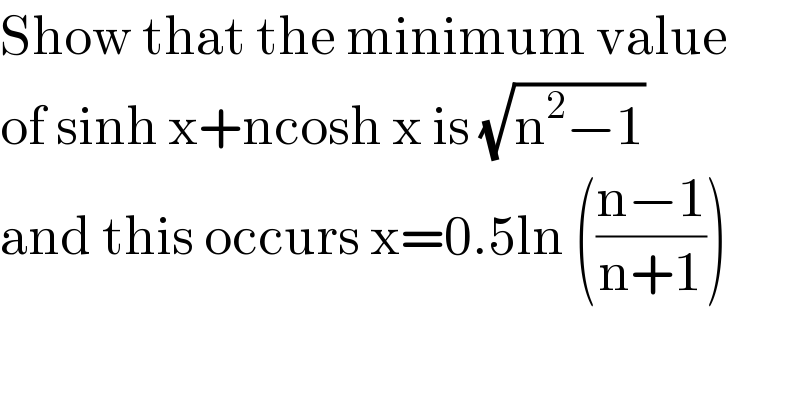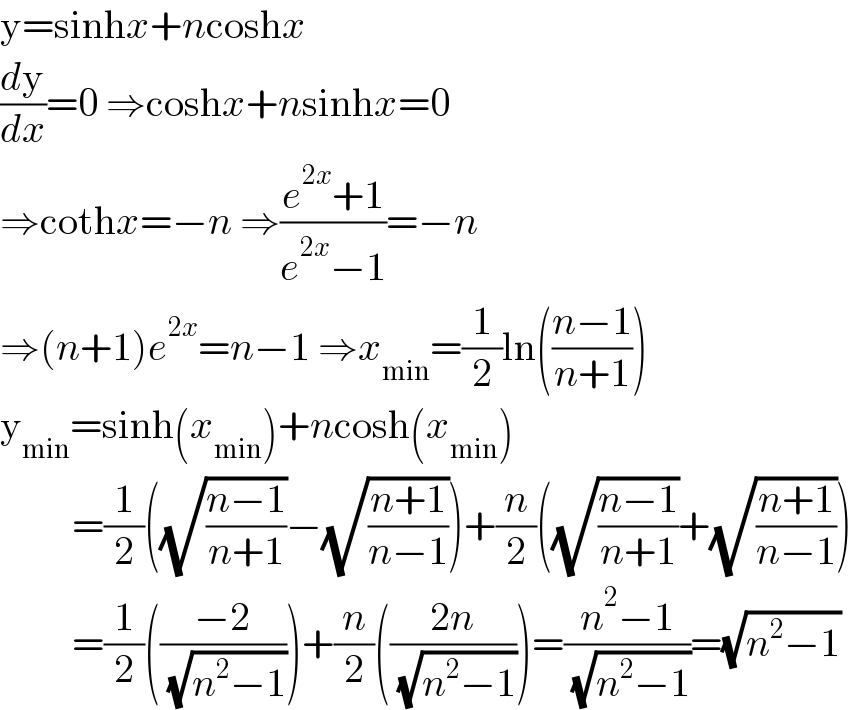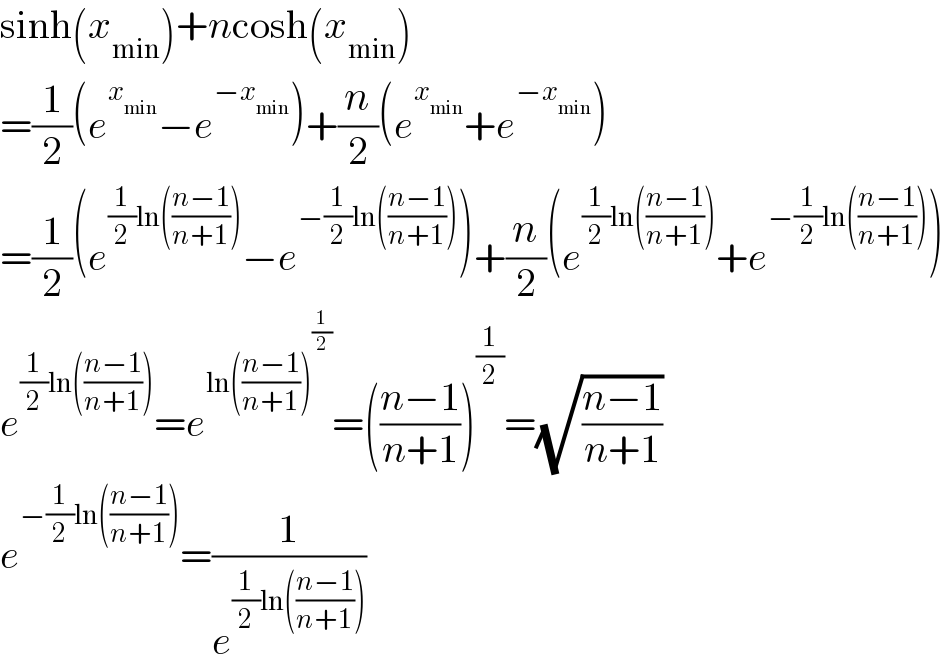
Question Number 178354 by Spillover last updated on 15/Oct/22

$$\mathrm{Show}\:\mathrm{that}\:\mathrm{the}\:\mathrm{minimum}\:\mathrm{value} \\ $$$$\mathrm{of}\:\mathrm{sinh}\:\mathrm{x}+\mathrm{ncosh}\:\mathrm{x}\:\mathrm{is}\:\sqrt{\mathrm{n}^{\mathrm{2}} −\mathrm{1}} \\ $$$$\mathrm{and}\:\mathrm{this}\:\mathrm{occurs}\:\mathrm{x}=\mathrm{0}.\mathrm{5ln}\:\left(\frac{\mathrm{n}−\mathrm{1}}{\mathrm{n}+\mathrm{1}}\right) \\ $$
Answered by Ar Brandon last updated on 16/Oct/22

$$\mathrm{y}=\mathrm{sinh}{x}+{n}\mathrm{cosh}{x} \\ $$$$\frac{{d}\mathrm{y}}{{dx}}=\mathrm{0}\:\Rightarrow\mathrm{cosh}{x}+{n}\mathrm{sinh}{x}=\mathrm{0} \\ $$$$\Rightarrow\mathrm{coth}{x}=−{n}\:\Rightarrow\frac{{e}^{\mathrm{2}{x}} +\mathrm{1}}{{e}^{\mathrm{2}{x}} −\mathrm{1}}=−{n} \\ $$$$\Rightarrow\left({n}+\mathrm{1}\right){e}^{\mathrm{2}{x}} ={n}−\mathrm{1}\:\Rightarrow{x}_{\mathrm{min}} =\frac{\mathrm{1}}{\mathrm{2}}\mathrm{ln}\left(\frac{{n}−\mathrm{1}}{{n}+\mathrm{1}}\right) \\ $$$$\mathrm{y}_{\mathrm{min}} =\mathrm{sinh}\left({x}_{\mathrm{min}} \right)+{n}\mathrm{cosh}\left({x}_{\mathrm{min}} \right) \\ $$$$\:\:\:\:\:\:\:\:\:=\frac{\mathrm{1}}{\mathrm{2}}\left(\sqrt{\frac{{n}−\mathrm{1}}{{n}+\mathrm{1}}}−\sqrt{\frac{{n}+\mathrm{1}}{{n}−\mathrm{1}}}\right)+\frac{{n}}{\mathrm{2}}\left(\sqrt{\frac{{n}−\mathrm{1}}{{n}+\mathrm{1}}}+\sqrt{\frac{{n}+\mathrm{1}}{{n}−\mathrm{1}}}\right) \\ $$$$\:\:\:\:\:\:\:\:\:=\frac{\mathrm{1}}{\mathrm{2}}\left(\frac{−\mathrm{2}}{\:\sqrt{{n}^{\mathrm{2}} −\mathrm{1}}}\right)+\frac{{n}}{\mathrm{2}}\left(\frac{\mathrm{2}{n}}{\:\sqrt{{n}^{\mathrm{2}} −\mathrm{1}}}\right)=\frac{{n}^{\mathrm{2}} −\mathrm{1}}{\:\sqrt{{n}^{\mathrm{2}} −\mathrm{1}}}=\sqrt{{n}^{\mathrm{2}} −\mathrm{1}} \\ $$
Commented by Spillover last updated on 16/Oct/22

$${thanks} \\ $$
Commented by Spillover last updated on 17/Oct/22

$$\mathrm{please}\:\mathrm{explain}\:\mathrm{the}\:\mathrm{second}\:\mathrm{line} \\ $$$$\mathrm{from}\:\mathrm{the}\:\mathrm{end}. \\ $$
Commented by Ar Brandon last updated on 17/Oct/22

$$\mathrm{sinh}\left({x}_{\mathrm{min}} \right)+{n}\mathrm{cosh}\left({x}_{\mathrm{min}} \right) \\ $$$$=\frac{\mathrm{1}}{\mathrm{2}}\left({e}^{{x}_{\mathrm{min}} } −{e}^{−{x}_{\mathrm{min}} } \right)+\frac{{n}}{\mathrm{2}}\left({e}^{{x}_{\mathrm{min}} } +{e}^{−{x}_{\mathrm{min}} } \right) \\ $$$$=\frac{\mathrm{1}}{\mathrm{2}}\left({e}^{\frac{\mathrm{1}}{\mathrm{2}}\mathrm{ln}\left(\frac{{n}−\mathrm{1}}{{n}+\mathrm{1}}\right)} −{e}^{−\frac{\mathrm{1}}{\mathrm{2}}\mathrm{ln}\left(\frac{{n}−\mathrm{1}}{{n}+\mathrm{1}}\right)} \right)+\frac{{n}}{\mathrm{2}}\left({e}^{\frac{\mathrm{1}}{\mathrm{2}}\mathrm{ln}\left(\frac{{n}−\mathrm{1}}{{n}+\mathrm{1}}\right)} +{e}^{−\frac{\mathrm{1}}{\mathrm{2}}\mathrm{ln}\left(\frac{{n}−\mathrm{1}}{{n}+\mathrm{1}}\right)} \right) \\ $$$${e}^{\frac{\mathrm{1}}{\mathrm{2}}\mathrm{ln}\left(\frac{{n}−\mathrm{1}}{{n}+\mathrm{1}}\right)} ={e}^{\mathrm{ln}\left(\frac{{n}−\mathrm{1}}{{n}+\mathrm{1}}\right)^{\frac{\mathrm{1}}{\mathrm{2}}} } =\left(\frac{{n}−\mathrm{1}}{{n}+\mathrm{1}}\right)^{\frac{\mathrm{1}}{\mathrm{2}}} =\sqrt{\frac{{n}−\mathrm{1}}{{n}+\mathrm{1}}} \\ $$$${e}^{−\frac{\mathrm{1}}{\mathrm{2}}\mathrm{ln}\left(\frac{{n}−\mathrm{1}}{{n}+\mathrm{1}}\right)} =\frac{\mathrm{1}}{{e}^{\frac{\mathrm{1}}{\mathrm{2}}\mathrm{ln}\left(\frac{{n}−\mathrm{1}}{{n}+\mathrm{1}}\right)} } \\ $$
